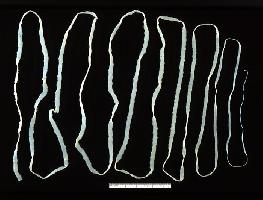
Greutăți și măsuri
| Lungime | de la 2 la 4 m |
|---|
Date biologice
| Durata de viață | de la 4 la 5 ani |
|---|
Descrierea animalului
The Pork tapeworm, scientifically known as Taenia solium, is a parasitic flatworm belonging to the class Cestoda. It is a zoonotic parasite, meaning it can be transmitted between animals and humans. This organism has a complex life cycle and a structure uniquely adapted to its parasitic way of living, making it a subject of medical and biological interest.Taenia solium can reach lengths of up to 2-3 meters, although some specimens have been reported to be longer. The body of the pork tapeworm is divided into segments known as proglottids, with a structure that ranges from immature, to mature, and ultimately to gravid (egg-filled) segments towards the end of its body. The head, or scolex, is relatively small and equipped with hooks and suckers, allowing the tapeworm to attach firmly to the intestinal wall of its host.
The life cycle of Taenia solium involves two hosts: humans and pigs. Humans become definitive hosts of the adult tapeworm by consuming undercooked or raw pork that contains cysticerci, the larval form of the parasite. Once ingested, the cysticerci attach to the human's small intestine, where they develop into adult tapeworms. These adult tapeworms produce eggs that are released into the environment through the host's feces, completing the cycle when pigs consume contaminated food or water.
In an alternative and more concerning route, humans can also become intermediate hosts if they ingest the eggs directly, through fecal-oral transmission, often due to poor hygiene practices. The ingested eggs hatch in the human intestine, releasing larvae that can migrate to various tissues and organs, including the brain, muscles, and eyes, forming cysts. This condition, known as cysticercosis, can lead to severe health issues, including seizures, muscle weakness, and, in the case of neurocysticercosis (involvement of the brain), potentially life-threatening complications.
The morphology of Taenia solium is specialized for its parasitic lifestyle. The scolex's hooks and suckers are critical for anchorage, preventing the tapeworm from being swept away by the host's intestinal movements. The body's segmented nature allows for growth by adding new proglottids, while the mature segments at the end of the chain are filled with eggs, ready to be released and spread the infection.
Diagnosis of taeniasis, the infection caused by the adult tapeworm, is typically made by identifying eggs or proglottids in fecal samples. Treatment involves the administration of antiparasitic medications, which are highly effective at eliminating the tapeworm. However, preventing transmission is paramount and includes measures such as proper cooking of pork, improved sanitation, and education about the risks of consuming undercooked meat.
In conclusion, Taenia solium, or the pork tapeworm, is a fascinating yet concerning parasite due to its ability to cause significant health problems in humans. Its complex life cycle, specialized morphology, and the dual role of humans as both definitive and intermediate hosts underscore the importance of understanding and preventing infections caused by this organism.
Animale similare
Fotografii noi cu animale
Top 10 animale
- Dolphin gull (Leucophaeus scoresbii)
- Diana monkey (Cercopithecus diana)
- Moustached guenon (Cercopithecus cephus)
- Greek tortoise (Testudo graeca)
- Stone loach (Barbatula barbatula)
- Galápagos tortoise (Geochelone nigra complex)
- Japanese macaque (Macaca fuscata)
- Russian tortoise (Testudo horsfieldii)
- Common flying dragon (Draco volans)
- Galápagos penguin (Spheniscus mendiculus)


